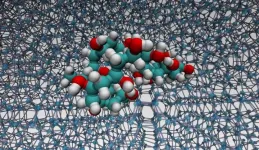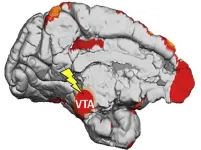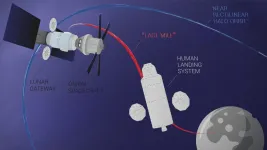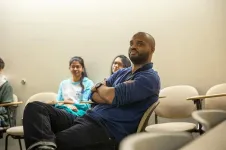Solving the puzzle of polymers binding to ice for Cryopreservation
2021-03-15
(Press-News.org) Cryoprotectants are used to protect biological material during frozen storage
They have to be removed when defrosting, and how much to use and how exactly they inhibit ice recrystallisation is poorly understood
The polymer poly(vinyl)alcohol (PVA) is arguably the most potent ice recrystallisation inhibitor and researchers from the University of Warwick have unravelled how exactly it works.
This newly acquired knowledge base provides novel guidelines to design the next generation of cryoprotectants
When biological material (cells, blood, tissues) is frozen, cryoprotectants are used to prevent the damage associated with the formation of ice during the freezing process. New polymeric cryoprotectants are emerging, alongside the established cryoprotectants, but how exactly they manage to control ice formation and growth is still largely unknown. This is especially true for PVA, a deceptively simple synthetic polymer that interacts with ice by means of mechanisms that have now been revealed at the atomistic level thanks to researchers from the University of Warwick.
Cryoprotectants are crucial when freezing biological material to lessen the cellular damage involved with the formation of ice. Ice re-crystallization, that is the process by which larger ice crystals grow at the expense of smaller ones, is one of the major issues affecting the current cryopreservation protocols and it is still poorly understood. Researchers from the University of Warwick have investigated how a rather popular polymer with the potential to be used in cryopreservation binds to the growing ice crystals.
In the paper, 'The atomistic details of the ice recrystallisation inhibition activity of PVA', published in the journal Nature Communications, researchers from the University of Warwick have found that, contrary to the emerging consensus, shorter or longer polymeric chains of poly(vinyl)alcohol (PVA) all bind to ice.
Up to now, the community has been working under the assumption that short polymers do not bind strongly enough to the ice crystals, but in this work Dr. Sosso and co-workers have demonstrated that it is the subtle balance between these binding interactions and the effective volume occupied by the polymers at the interface with ice that determine their effectiveness in hindering ice re-crystallization.
This work brings together experimental measurements of ice recrystallization inhibition and computer simulations. The latter are invaluable tools to gain microscopic insight into processes such as the formation of ice, as they are able to see what is happening in very fast or very small processes which are hard to see via even the most advanced experimental techniques.
This work sheds new light onto the fundamental principles at the heart of ice re-crystallization, pinpointing design principles that can be directly harnessed to design the next generation of cryoprotectants. This achievement is a testament to the strength of what is affectionately known as 'Team Ice' at Warwick, an ever-growing collaborative network with the potential to make a huge impact on many aspects of ice formation, from atmospheric science to medicinal chemistry.
Fabienne Bachtiger, a PhD student working in the research group of Dr. Sosso (Department of Chemistry) who has spearheaded this work, explains:
"We have found that even rather short chains of PVA, containing just ten polymeric units, do bind to ice, and that small block co-polymers of PVA bind too. It is important for the experimental community to know this, as they have been working under different assumptions up to now. In fact, this means we can successfully use much smaller polymers than previously thought. This is crucial information to aid the development of new more active cryoprotectants."
Dr. Gabriele Sosso, from the Department of Chemistry at the University of Warwick, who is leading a substantial computational effort to investigate the formation of ice in biological matter, points out that:
"With this contribution we have added a crucial piece to the puzzle of how exactly polymeric cryoprotectants interact with growing ice crystals. This is part of a larger body of computational and theoretical work that my group is pursuing with the intent to understand how cryoprotectants work at the molecular level, so as to identify designing principles that can be directly probed by our experimental colleagues. Warwick is the perfect place to further our understanding of ice, and this work showcases the impact of the very exciting collaboration between my research group and the Gibson Group."
Professor Matthew Gibson, from the Department of Chemistry and Warwick Medical School at the University of Warwick adds: "Ice re-crystallization is a real challenge in cryobiology, leading to damage to cells but also in frozen foods or infrastructure. Understanding how even this 'simple' polymer works to control ice re-crystallization is a major step forward to discover new cryoprotectants, and ultimately to use them in the real world."
INFORMATION:
15 MARCH 2021
[Attachments] See images for this press release:

ELSE PRESS RELEASES FROM THIS DATE:
2021-03-15
Researchers uncovered for the first time what happens in animals' brains when they learn from subconscious, visual stimuli. In time, this knowledge can lead to new treatments for a number of conditions. The study, a collaboration between KU Leuven, Massachusetts General Hospital, and Harvard was published in Neuron.
An experienced birdwatcher recognises many more details in a bird's plumage than the ordinary person. Thanks to extensive training, he or she can identify specific features in the plumage. This learning process is not only dependent on conscious processes. Previous research has shown that when people are rewarded during the presentation of visual stimuli that are not consciously perceivable, ...
2021-03-15
Researchers from Skoltech and the Massachusetts Institute of Technology have analyzed several dozen options to pick the best one in terms of performance and costs for the 'last mile' of a future mission to the Moon - actually delivering astronauts to the lunar surface and back up to the safety of the orbiting lunar station. The paper was published in the journal Acta Astronautica.
Ever since December 1972, when the crew of Apollo 17 left the lunar surface, humans have been eager to return to the Moon. In 2017, the US government launched the Artemis program, which intends ...
2021-03-15
An RCSI study conducted in Beaumont Hospital in Dublin has found that surgery, rather than antibiotics-only, should remain as the mainstay of treatment for acute uncomplicated appendicitis.
Published in the Annals of Surgery and led by researchers from the RCSI University of Medicine and Health Sciences, the study entitled the COMMA trial (Conservative versus Open Management of Acute uncomplicated Appendicitis) examined the efficacy and quality of life associated with antibiotic-only treatment of acute uncomplicated appendicitis versus surgical intervention. The results revealed that antibiotic-only treatment resulted in high recurrence rates and an inferior quality ...
2021-03-15
Drugs such as beta-adrenergic antagonists (beta blockers) have been linked to a range of adverse effects, including depression. But how reliable are these data, and which psychiatric side effects might indeed be caused by these drugs? These questions have been addressed by a team of researchers from Charité - Universitätsmedizin Berlin, whose comprehensive meta-analysis has been published in Hypertension*. While treatment with beta blockers was not found to be associated with an increased incidence of depression, some studies recorded higher levels of sleep disturbance.
Beta-adrenergic ...
2021-03-15
During the past decade the European People's Party in the European Parliament was criticized for its unwillingness to vote for measures that would sanction the Hungarian Fidesz government, which is accused of breaching key democratic principles.
Researchers have said the EPP protected Fidesz in order to safeguard Hungarian votes in its ranks and protect their own interests, but this support had weakened by 2019, when Fidesz was suspended from the EPP.
Researchers analysed the votes of EPP MEPs for 24 resolutions covering the protection of EU fundamental values ...
2021-03-15
(Boston)-- Warning signs for Alzheimer's disease (AD) can begin in the brain years before the first symptoms appear. Spotting these clues may allow for lifestyle changes that could possibly delay the disease's destruction of the brain.
"Improving the diagnostic accuracy of Alzheimer's disease is an important clinical goal. If we are able to increase the diagnostic accuracy of the models in ways that can leverage existing data such as MRI scans, then that can be hugely beneficial," explained corresponding author Vijaya B. Kolachalama, PhD, assistant professor of medicine at Boston University School ...
2021-03-15
COLUMBUS, Ohio - An analysis of historic and projected simulations from 19 global climate models shows that, because of climate change, the temperature in the Antarctic peninsula will increase by 0.5 to 1.5 degrees Celsius by 2044.
The projections also showed that precipitation - a threat to ice if it manifests as rain - will likely increase on the peninsula by about 5% to 10% over that same time period.
The estimates were published recently in the journal Climate Dynamics.
"We are concerned about these findings. We've been seeing overall quite big changes on the peninsula, generally getting warmer and ice shelves and glaciers discharging into the ocean," said David Bromwich, a leading author of the study and a research professor at The Ohio State University ...
2021-03-15
PROVIDENCE, R.I. [Brown University] -- Proposals to create a national gun registry have long been met with fierce opposition from gun rights advocates. While proponents say a registry would help in tracking guns used in crimes, opponents worry that it would compromise privacy and could be used by the federal government to confiscate firearms. Now, a team of Brown University computer scientists has devised a way of implementing a registry that may allay some of those concerns.
They propose a database that uses advanced encryption to protect privacy. The encryption scheme allows the database to be searched without being decrypted, which means people querying the database see only the records they're looking for and nothing else. Meanwhile, the system places control of data ...
2021-03-15
Lemurs can use their sense of smell to locate fruit hidden more than 50 feet away in the forest--but only when the wind blows the fruit's aroma toward them, according to a study published in the American Journal of Physical Anthropology.
"This is the first time research has demonstrated that primates can track a distant smell carried by the wind," said anthropologist Elena Cunningham, a clinical associate professor of molecular pathobiology at NYU College of Dentistry and the study's lead author.
Many animals use their sense of smell to locate food. However, less is known about whether primates can smell food that is far away, or if they instead rely on visual cues or memory to find their next meal.
Because many primates--including ring-tailed lemurs, ...
2021-03-15
CORVALLIS, Ore. - Oregon State University researchers analyzed more than 17,000 public comments focused on orca conservation in the state of Washington and found that the most common emotional sentiments were trust, anticipation and fear.
The recently published findings have important implications because they provide conservation managers a way to convert a large volume of information to a manageable amount that can help them understand why people might support or reject management actions, the researchers said.
"Emotions are intertwined in our decision-making, often playing a substantive role in public evaluations of conservation policies," said Kelly Biedenweg, an author ...
LAST 30 PRESS RELEASES:
[Press-News.org] Solving the puzzle of polymers binding to ice for Cryopreservation





